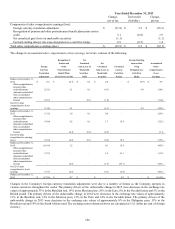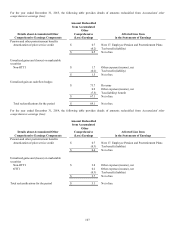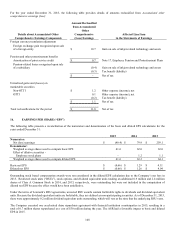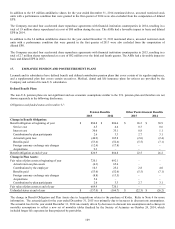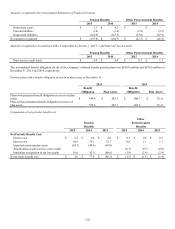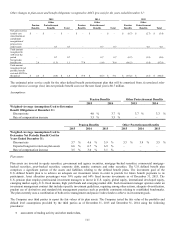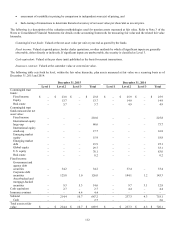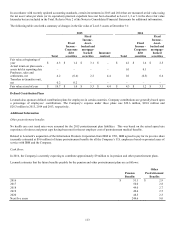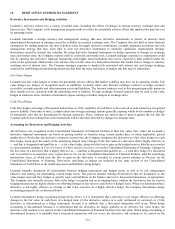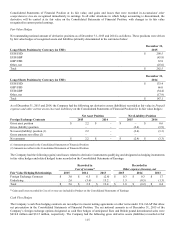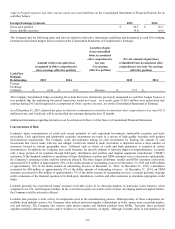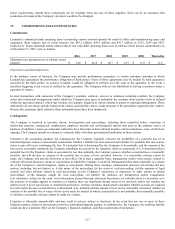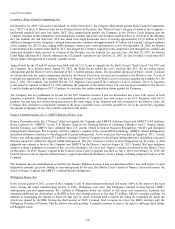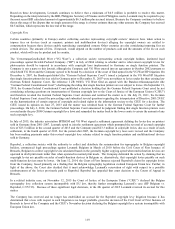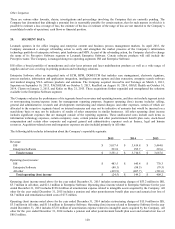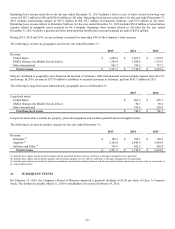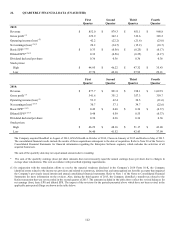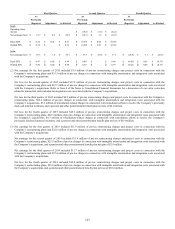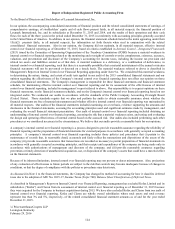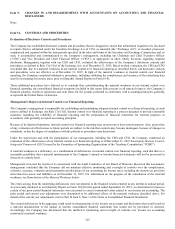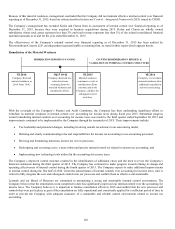Lexmark 2015 Annual Report Download - page 120
Download and view the complete annual report
Please find page 120 of the 2015 Lexmark annual report below. You can navigate through the pages in the report by either clicking on the pages listed below, or by using the keyword search tool below to find specific information within the annual report.
116
value in Prepaid expenses and other current assets (Accrued liabilities) on the Consolidated Statements of Financial Position for its
cash flow hedges:
Foreign Exchange Contracts
2015
2014
Gross asset position
$
20.5
$
28.3
Gross (liability) position
(9.5)
(8.6)
The Company had the following gains and (losses) related to derivative instruments qualifying and designated as cash flow hedging
instruments and related hedged items recorded on the Consolidated Statements of Comprehensive Earnings:
Location of gain
(loss) reclassified
from Accumulated
other comprehensive
Pre-tax amount of gain (loss)
Amount of after-tax gain (loss)
loss into
reclassified from Accumulated other
recognized in Other comprehensive
Net earnings
comprehensive loss into Net earnings
(loss) earnings (effective portion)
(effective portion)
(effective portion)
Cash Flow
Hedging
Relationships
2015
2014
2015
2014
Foreign
Exchange
Contracts
$
(6.0)
$
15.9
Revenue
$
73.7
$
–
The Company discontinued hedge accounting for certain derivative instruments previously designated as cash flow hedges because it
was probable that the underlying forecasted transaction would not occur. As a result, gains of $0.9 million were reclassified into
earnings during 2015 and recognized as a component of Other expense (income), net on the Consolidated Statements of Earnings.
As of December 31, 2015, deferred net gains on derivative instruments recorded in Accumulated other comprehensive loss were $11.0
million pre-tax, and if realized, will be reclassified into earnings during the next 12 months.
Additional information regarding derivatives can be referenced in Note 3 of the Notes to Consolidated Financial Statements.
Concentrations of Risk
Lexmark’s main concentrations of credit risk consist primarily of cash equivalent investments, marketable securities and trade
receivables. Cash equivalents and marketable securities investments are made in a variety of high quality securities with prudent
diversification requirements. The Company seeks diversification among its cash investments by limiting the amount of cash
investments that can be made with any one obligor. Credit risk related to trade receivables is dispersed across a large number of
customers located in various geographic areas. Collateral such as letters of credit and bank guarantees is required in certain
circumstances. In addition, the Company uses credit insurance for specific obligors to limit the impact of nonperformance. Lexmark
sells a large portion of its products through third-party distributors and resellers and original equipment manufacturer (“OEM”)
customers. If the financial condition or operations of these distributors, resellers and OEM customers were to deteriorate substantially,
the Company’s operating results could be adversely affected. The three largest distributor, reseller and OEM customers collectively
represented $119 million or approximately 22% of the dollar amount of outstanding invoices at December 31, 2015 and $108 million
or approximately 19% of the dollar amount of outstanding invoices at December 31, 2014. At December 31, 2015, a distributor
accounted for $48 million or approximately 9% of the dollar amount of outstanding invoices. At December 31, 2014, an OEM
customer accounted for $42 million or approximately 7% of the dollar amount of outstanding invoices. Lexmark performs ongoing
credit evaluations of the financial position of its third-party distributors, resellers and other customers to determine appropriate credit
limits.
Lexmark generally has experienced longer accounts receivable cycles in its emerging markets, in particular, Latin America, when
compared to its U.S. and European markets. In the event that accounts receivable cycles in these developing markets lengthen further,
the Company could be adversely affected.
Lexmark also procures a wide variety of components used in the manufacturing process. Although many of these components are
available from multiple sources, the Company often utilizes preferred supplier relationships to better ensure more consistent quality,
cost and delivery. The Company also sources some printer engines and finished products from OEMs. Typically, these preferred
suppliers maintain alternate processes and/or facilities to ensure continuity of supply. Although Lexmark plans in anticipation of its


